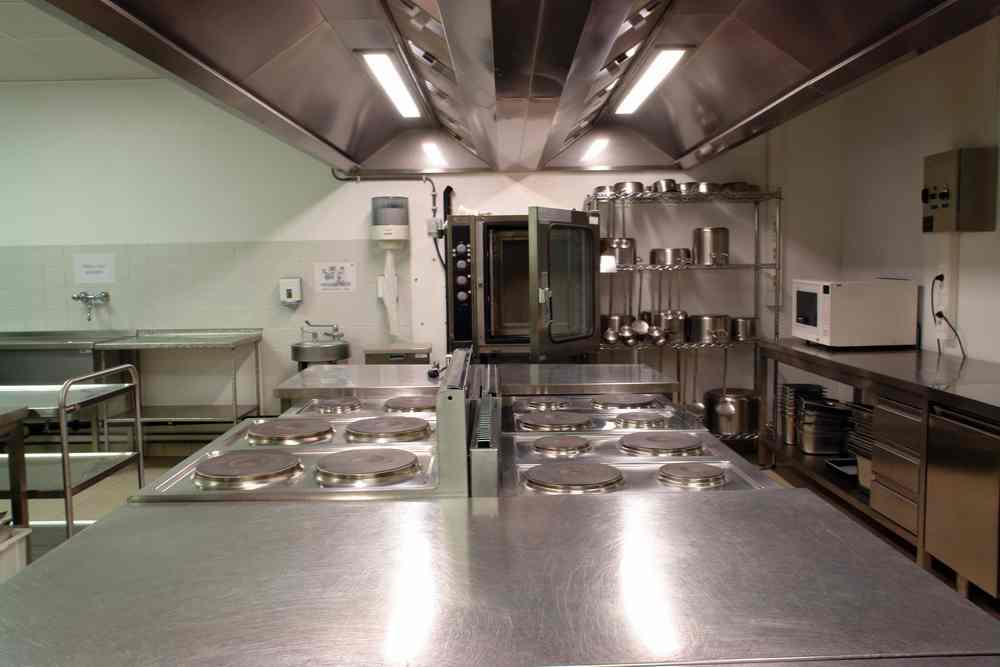How to Clean Commercial Kitchen Exhaust

Commercial kitchens are known for their busy and fast-paced environments. With the constant cooking and food preparation, it’s no surprise that the kitchen exhaust system can quickly become dirty and clogged. Regular cleaning of the kitchen exhaust is not only essential for maintaining a clean and healthy environment but also for complying with safety regulations. In this article, we will explore the importance of cleaning commercial kitchen exhaust systems and provide a step-by-step guide on how to effectively clean them.
Ontario-wide Kitchen Exhaust and Hood Cleaning – Best prices and service guaranteed.
The Importance of Cleaning Commercial Kitchen Exhaust
A commercial kitchen exhaust system plays a crucial role in maintaining air quality, preventing fire hazards, and ensuring the overall safety of the kitchen. Here are some key reasons why regular cleaning of the kitchen exhaust is essential:
- Fire Prevention: The accumulation of grease and other flammable substances in the exhaust system can pose a significant fire hazard. According to the National Fire Protection Association (NFPA), nearly one-third of restaurant fires are caused by grease buildup in the kitchen exhaust system.
- Air Quality: A clean kitchen exhaust system helps to remove smoke, odors, and airborne contaminants from the kitchen. This improves the overall air quality, creating a healthier environment for both employees and customers.
- Energy Efficiency: A clogged exhaust system can hinder the airflow, making the kitchen ventilation less efficient. This can lead to increased energy consumption and higher utility bills. Regular cleaning ensures optimal performance and energy efficiency.
- Compliance with Regulations: Health and safety regulations require commercial kitchens to maintain clean and functional exhaust systems. Failure to comply with these regulations can result in fines, penalties, and even closure of the establishment.
Ontario-wide Kitchen Exhaust and Hood Cleaning – Best prices and service guaranteed.
Step-by-Step Guide to Cleaning Commercial Kitchen Exhaust
Now that we understand the importance of cleaning the kitchen exhaust system, let’s dive into the step-by-step process of how to effectively clean it:
1. Safety Precautions
Prior to starting the cleaning process, it is crucial to take the necessary safety precautions. This includes wearing protective clothing, such as gloves and goggles, to protect against chemicals and debris. Additionally, ensure that the kitchen is properly ventilated to avoid inhaling any fumes.
2. Turn Off the Exhaust System
Before cleaning, it is important to turn off the exhaust system to prevent any accidents or injuries. This can usually be done by switching off the power supply or shutting down the main control panel.
Ontario-wide Kitchen Exhaust and Hood Cleaning – Best prices and service guaranteed.
3. Remove and Clean Filters
The first step in cleaning the kitchen exhaust system is to remove and clean the filters. These filters are designed to trap grease and other particles, preventing them from entering the ductwork. Here’s how to clean the filters:
- Remove the filters from the exhaust hood. Depending on the type of filters, they can be easily detached or require unscrewing.
- Scrape off any visible grease or debris from the filters using a scraper or brush.
- Soak the filters in a sink or large container filled with warm water and a degreasing detergent. Allow them to soak for at least 15-20 minutes to loosen the grease.
- After soaking, scrub the filters using a brush to remove any remaining grease. Pay special attention to the corners and crevices.
- Rinse the filters thoroughly with clean water to remove any detergent residue.
- Allow the filters to air dry completely before reinstalling them.
Ontario-wide Kitchen Exhaust and Hood Cleaning – Best prices and service guaranteed.
4. Clean the Exhaust Hood and Ductwork
Once the filters are cleaned and drying, it’s time to clean the exhaust hood and ductwork. Here’s how to do it:
- Prepare a cleaning solution by mixing warm water with a degreasing detergent or a commercial kitchen exhaust cleaner.
- Using a brush or sponge, apply the cleaning solution to the interior and exterior surfaces of the exhaust hood. Pay close attention to areas with visible grease buildup.
- Scrub the surfaces thoroughly to remove any grease or residue. For hard-to-reach areas, use a long-handled brush or specialized cleaning tools.
- Rinse the hood with clean water to remove any cleaning solution or residue.
- Next, clean the ductwork by inserting a specialized brush or scraper into the ducts. Move the brush or scraper back and forth to dislodge any grease or debris.
- Use a vacuum cleaner or a wet-dry vacuum to remove the dislodged grease and debris from the ductwork.
- Finish by wiping down the interior surfaces of the ductwork with a clean cloth or sponge.
Ontario-wide Kitchen Exhaust and Hood Cleaning – Best prices and service guaranteed.
5. Reinstall Filters and Test the System
Once the exhaust hood and ductwork are thoroughly cleaned, it’s time to reinstall the filters and test the system. Here’s what to do:
- Ensure that the filters are completely dry before reinstalling them into the exhaust hood.
- Secure the filters in place, making sure they are properly aligned and fitted.
- Turn on the exhaust system and check for proper airflow. Listen for any unusual noises or vibrations that may indicate a problem.
- Test the exhaust system by holding a piece of tissue paper near the hood. The paper should be drawn towards the hood, indicating proper airflow.
Ontario-wide Kitchen Exhaust and Hood Cleaning – Best prices and service guaranteed.
Cleaning the commercial kitchen exhaust system is crucial for maintaining a safe and healthy environment. Regular cleaning helps prevent fire hazards, improves air quality, enhances energy efficiency, and ensures compliance with regulations. By following the step-by-step guide outlined in this article, you can effectively clean the kitchen exhaust system and keep your commercial kitchen running smoothly. Remember to prioritize safety, remove and clean filters, clean the exhaust hood and ductwork, and test the system after cleaning. By doing so, you can create a clean and safe environment for your staff and customers.
Learn more about “Home Cleaning Kitchen Exhaust” here.
Frequently Asked Questions About How to Clean Commercial Kitchen Exhaust

What Is the Recommended Frequency for Cleaning Commercial Kitchen Exhaust Systems?
The frequency of cleaning a commercial kitchen exhaust system varies depending on several factors, such as the volume and type of cooking. Here’s a general guideline based on the National Fire Protection Association (NFPA) standards:
High-volume operations like fast-food restaurants should aim for quarterly cleaning.
Moderate-volume establishments, such as sit-down restaurants or hotel kitchens, should opt for semi-annual cleaning.
Low-volume kitchens, like those in churches or senior centers, may only need annual cleaning.
It is critical to adhere to these guidelines to minimize the risk of grease fires, stay compliant with local fire codes, and maintain a healthy working environment. Missed or delayed cleanings can result in reduced exhaust performance and even pose serious fire hazards.
What Chemicals Are Safe to Use for Commercial Kitchen Exhaust Cleaning?
When it comes to chemical degreasers, you should opt for commercial-grade products specifically designed for kitchen exhaust cleaning. These degreasers break down grease, oil, and grime more effectively than household cleaners. However, it is crucial to check that the chemical degreaser you choose is compatible with the material of your exhaust system.
Some of the best degreasers are non-toxic, non-flammable, and biodegradable, minimizing environmental impact and ensuring staff safety. Always follow the manufacturer’s guidelines for usage, including recommended dilution ratios and contact times, to achieve optimal results. Never mix chemicals unless specified, as it can lead to hazardous reactions.
Should I Be Concerned About Grease Traps and Ductwork?
Absolutely, you should be! Grease traps and ductwork are crucial components of a commercial kitchen exhaust system that often get overlooked. These areas are notorious for accumulating heavy grease deposits, which can pose serious fire risks if not cleaned regularly. Beyond that, neglected grease traps can become breeding grounds for bacteria, leading to unpleasant odors and potential health concerns.
Professionally trained technicians use specialized equipment, such as high-pressure hot water systems, to thoroughly clean these hard-to-reach areas. A full-service cleaning should include the exhaust hood, grease traps, ductwork, and exhaust fan to ensure the system is operating efficiently and safely.
How Can I Verify That My Exhaust System Is Cleaned to Code?
Cleaning to code means that your exhaust system should meet the standards set forth by NFPA 96, which is the benchmark for ventilation control and fire protection of commercial cooking operations. After a professional cleaning service, you should receive a detailed report, including before and after photos, demonstrating that the cleaning meets these standards.
The company should also attach a certification sticker to the hood of your system, indicating the date of cleaning and the due date for the next service. This serves as a visual reminder for your maintenance schedule and can be valuable documentation for inspections.
What Should I Look for When Hiring a Professional Exhaust Cleaning Company?
When selecting a professional exhaust cleaning company, consider the following factors:
Certifications: Make sure the company holds proper certifications, like those from the International Kitchen Exhaust Cleaning Association (IKECA) or equivalent bodies. Certification indicates that the company adheres to industry standards.
Experience: Longevity in the business usually equates to a high level of expertise. Companies with many years of experience are likely to provide better service.
Insurance: Ensure that the company has appropriate liability insurance to cover any accidental damage that might occur during cleaning.
References: Request and check references. Satisfied customers are a good indicator of quality service.
Documentation: The company should provide detailed reports and photographic evidence to prove that the cleaning meets industry and safety standards.
Taking these factors into account can help you make an informed decision and ensure that your commercial kitchen exhaust system is maintained to the highest standards.
- hood cleaning
- How to Clean Commercial Kitchen Exhaust
- kitchen exhaust cleaning
- restaurant hood cleaning







